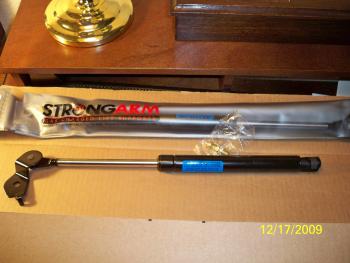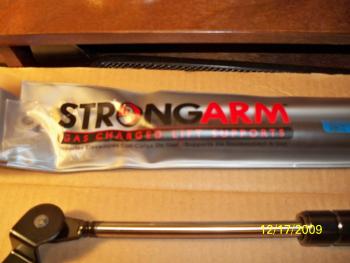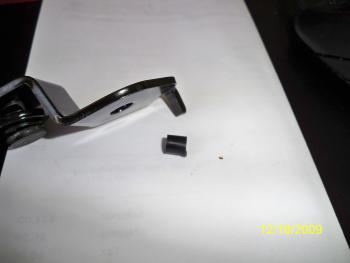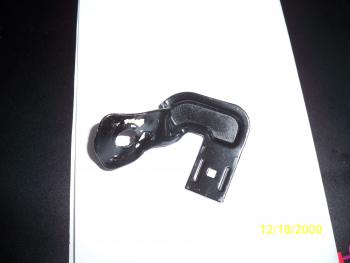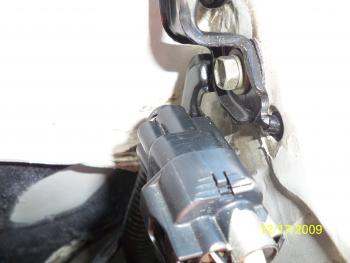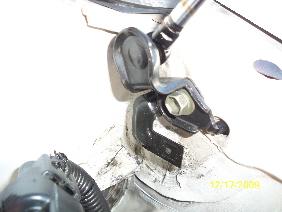
sk1951
Regular Member-
Posts
48 -
Joined
-
Last visited
Content Type
Profiles
Forums
Events
Gallery
Store
Articles
Videos
News & Articles
Everything posted by sk1951
-
Im goe'n with air in the line. Don't think they put organic on the Lex. He may have put ceramic. But the low pedel and weird pressure...air I think. Let us know.
-
Wrote this for my 96 but it covers your o2 also. Good luck. I love this forum but it does get confusing. This is what "I" am going to do with my 96 es300 w/125k mi. 1. The manual says to "inspect" at 125k but says nothing else about oil transfusion or what to use. 2. The dip stick says to use Dex II and to check the rear end oil at the filler hole. However my understanding is that Dex III can be used in place of all before it. I am not sure when Dex II was superseded/discontinued but I thought it was before 96 as stated below. I am sure the stick is OEM and has all the jap lingo on it. I concluded that maybe the stick is older than 96 but then what did the factory really use? I assume it had to be Dex III. (Democratic disclaimer: No disrespect meant on the Jap statement.) 3. The forum seems avid against using Dexron. So I called the Dealer...Bell Road Lexus in Phoenix @ (602) 866-1474 and they told me...: Pre 1999- Dexron III ATF. 1999 to 2004- Toyota ATF. 2004+ World Standard ATF what ever that is...you new guys can fight it out. I asked about the synthetic and he said with older cars it would not really matter but suggested "no". I asked about using the Valvoline v v337 Dex/Merc Extended Life and he said it was a good product and a good replacement for the Dexron. 5. So...I want all the oil changed out so I am doing the flush method irregardless of the damage threat (I'm such a rebel) and pulling/cleaning the pan/changing the internal screen filter. And I am using the Extended Life Valvoline. If interested in the Valvoline I have posted more info on it...read on: http://www.valvoline.com/products/consumer...ission-fluid/37 Overview from the site above: MaxLife DEX/MERC ATF contains a blend of superior base oils and a unique additive package to help extend the life of transmissions with over 75,000 miles. It is formulated to maximize transmission performance, reduce transmission wear, and improve and maintain smooth shifting longer than conventional fluids. MaxLife DEX/MERC ATF is compatible with new and rebuilt transmissions and will not void new car warranties. Recommended for use where DEXRON, DEXRON II, III and VI, Toyota T-IV and WS, MERCON®, MERCON® SP and LV, Allison TES 295 and 389, Nissan Matic-D, Matic-J and Matic-K, Honda Z-1 (except CVT), Mercedes NAG-1, Mitsubishi Diamond SP-II and SP-III and many others are required. WIKIPEDIA: All previous DEXRON specifications were replaced once DEXRON-VI was introduced. There are no valid approved products that carry the DEXRON approval unless they have a DEXRON-VI approval and associated license. DEXRON-IIE has been surpassed by DEXRON-III as of January 1, 1994. It is no longer available and its use is no longer recommended. DEXRON-IIE is not compatible in systems requiring DEXRON-III or DEXRON-VI. DEXRON-III is not compatible with the most recently designed transmissions, and the use of these earlier type fluids could result in transmission damage. All DEXRON-III licenses expired at the end of 2006, and will not be renewed. Beyond that date, General Motors will only support the use of DEXRON-VI fluids for use in Hydra-Matic transmissions. Fluids claiming DEXRON-III type performance continue to be sold under abbreviated names such as Dex/Merc, and D/M however since the DEXRON-III licensing system no longer exists, these fluids are not regulated in any way. DEXRON-VI DEXRON-VI was introduced in 2005. It was designed to replace all prior specifications, and is therefore backwards-compatible with applications calling for DEXRON of any type. The specification (GMN 10060) defines both a performance level and specific additives that provide improved shift feel, friction durability and oxidative stability compared to earlier specified fluids.
-
-
I have had every problem solved by this forum. It is laughable that this proclaimed "illusive" filter runs the gambit of may exist...maybe not. My manual does not cover it. The strings are for the most part worthless in none decrypt descriptions. It seems that some have found it but are illusive as to where. Some claim a secret box with special tabs. One guys says it is by the gas pedal under the carpet...but toward the front of the car...now really...what does that mean?!?!? So could someone kindly post just one post that is on point with a picture to prove this chupacabra Yettie filters existence! And tell us all of your excursion into the depth of this unknown abyss... Hey...all in fun here but really...I would like to change it if I can find it. :D Thanks
-
When and if you return, please attempt to learn to use the quote feature. It ain't rocket science. This string is a joke!!! I have found a wealth of information here. A nice man posted a how to for tail lights WITH PICTURES that helped me immensely. I posted a how to on hood struts...WITH PICTURES. But if you read through this string there is a lot of talk about how easy it is to find and replace and how the owners manual covers all...but no one says where or how to! The owners manual does not cover my 96 es300. This supposed filter is still elusive to me and this string was a waist of my time. Thanks for nothing guys!!!! *s* :P
-
Find a clean spot or put something under the car to locate the exact place it is driping from.
-
Transmission Dipstick Wont Go Back In!
sk1951 replied to gav_logan's topic in 92 - 06 Lexus ES250/300/330
LOL...that was what I was going to say. Wonderif it worked? -
There is a cabin air filter on many models.
-
Are u sure the car is worth it? With that many miles doing a top end will blow out the bottom end.
-
Are u sure the car is worth it?
-
Hole In Rear Of My Exhaust ,temporary Repairs?suggestions
sk1951 replied to pete rock's topic in 92 - 06 Lexus ES250/300/330
muffler tape. any auto parts store has it. -
Wish there was a way to attach a sound clip here. My first guess would be bad gas causing problems. Then tapit noise. Is it a lower end noise like a rod knock? Or a weird clicking taping knock? All the time noise or only when revved up?
-
Jake or Juliet: Sounds like you know the problem. Not enough juice to start the engine. If you have a slow cranking situation you might start with a new battery.
-
Out of curiosity, if you depress the brake pedal, let up on the pedal and then depress the pedal again do the brakes respond differently the second time? Showing your age dude! Just kidding.
-
Oh the buyers remorse! So exciting to get a new car...well to you anyway. I totally understand. Then the reality of care and new scratches sets in! You did not give us the mileage so it is harder to extrapolate. But if you have 60 days...I would use it to the fullest advantage and get everything you can fixed or repaired. Other wise you will be back here...like the rest of us...looking for more info on how to fix stuff! Air in the line was my thought also. This is not a real common occurrence. For air to get in the fluid level has to drop significantly...or it is sucking in from some place else which will normally leak also or an improper installation of a part has happened. Look for oil on the inside of the tires or spots where you park and notice where the spot was located to the car. Could be a blown caliper leaking or something else leaking. Also if brake pads are worn differently this can show a problem sign. If the brake fluid is black or dirty this lends to a car that was not cared for or has really high miles. Lexus brakes can go 100k or better with proper care. I would be all over that car checking all fluids for color/general condition and proper level. Check condition of belts and hoses...and that your hood stays up by itself! Actually...healthy struts will lift the hood on their own on a Lexus. So on to an off topic subject that I am sure you will be back searching. Transmissions are very costly so I believe in maintaining at least every 50k. I would do a flush at 125/150k. Some feel that color is not important but I like all my fluids a nice clean color. Synthetics are really preferred but I believe with proper care and normal use regular oils work fine. Some claim not to switch to a synthetics from petroleum especially on high mileage cars. As stated get as much previous records as possible. Lexus can do a check for what they have on file with the vin number. We had a big discussion on trany fluid and this is what I found. I cut out the parts not for your car. Hope it helps. 1. The manual says to "inspect" at 125k but says nothing else about oil transfusion or what to use. I think that is too many miles to wait especially if you drive hard miles. 3. The forum seems avid against using Dexron. So I called the Dealer...Bell Road Lexus in Phoenix @ (602) 866-1474 and they told me...: Pre 1999- Dexron III ATF. 1999 to 2004- Toyota ATF. 2004+ World Standard ATF what ever that is...you new guys can fight it out. I asked about the synthetic and he said with older cars it would not really matter but suggested "no". I asked about using the Valvoline vv337 Dex/Merc Extended Life and he said it was a good product and a good replacement for the Dexron or Toyota. 5. So...I want all the oil changed out so I am doing the flush method irregardless of the damage threat (I'm such a rebel) and pulling/cleaning the pan/changing the internal screen filter. And I am using the Extended Life Valvoline. If interested in the Valvoline I have posted more info on it...read on: http://www.valvoline.com/products/consumer...ission-fluid/37 Overview from the site above: MaxLife DEX/MERC ATF contains a blend of superior base oils and a unique additive package to help extend the life of transmissions with over 75,000 miles. It is formulated to maximize transmission performance, reduce transmission wear, and improve and maintain smooth shifting longer than conventional fluids. MaxLife DEX/MERC ATF is compatible with new and rebuilt transmissions and will not void new car warranties. Recommended for use where DEXRON, DEXRON II, III and VI, Toyota T-IV and WS, MERCON®, MERCON® SP and LV, Allison TES 295 and 389, Nissan Matic-D, Matic-J and Matic-K, Honda Z-1 (except CVT), Mercedes NAG-1, Mitsubishi Diamond SP-II and SP-III and many others are required.
-
I love this forum but it does get confusing. This is what "I" am going to do with my 96 es300 w/125k mi. and what I learned about the T oils. 1. The manual says to "inspect" at 125k but says nothing else about oil transfusion or what to use. 2. The dip stick says to use Dex II and to check the rear end oil at the filler hole. However my understanding is that Dex III can be used in place of all before it. I am not sure when Dex II was superseded/discontinued but I thought it was before 96 as stated below. I am sure the stick is OEM and has all the jap lingo on it. I concluded that maybe the stick is older than 96 but then what did the factory really use? I assume it had to be Dex III. (Democratic disclaimer: No disrespect meant on the Jap statement.) 3. The forum seems avid against using Dexron. So I called the Dealer...Bell Road Lexus in Phoenix @ (602) 866-1474 and they told me...: Pre 1999- Dexron III ATF. 1999 to 2004- Toyota ATF. 2004+ World Standard ATF what ever that is...you new guys can fight it out. I asked about the synthetic and he said with older cars it would not really matter but suggested "no". I asked about using the Valvoline v v337 Dex/Merc Extended Life and he said it was a good product and a good replacement for the Dexron. 5. So...I want all the oil changed out so I am doing the flush method irregardless of the damage threat (I'm such a rebel) and pulling/cleaning the pan/changing the internal screen filter. And I am using the Extended Life Valvoline. If interested in the Valvoline I have posted more info on it...read on: http://www.valvoline.com/products/consumer...ission-fluid/37 Overview from the site above: MaxLife DEX/MERC ATF contains a blend of superior base oils and a unique additive package to help extend the life of transmissions with over 75,000 miles. It is formulated to maximize transmission performance, reduce transmission wear, and improve and maintain smooth shifting longer than conventional fluids. MaxLife DEX/MERC ATF is compatible with new and rebuilt transmissions and will not void new car warranties. Recommended for use where DEXRON, DEXRON II, III and VI, Toyota T-IV and WS, MERCON®, MERCON® SP and LV, Allison TES 295 and 389, Nissan Matic-D, Matic-J and Matic-K, Honda Z-1 (except CVT), Mercedes NAG-1, Mitsubishi Diamond SP-II and SP-III and many others are required. WIKIPEDIA: All previous DEXRON specifications were replaced once DEXRON-VI was introduced. There are no valid approved products that carry the DEXRON approval unless they have a DEXRON-VI approval and associated license. DEXRON-IIE has been surpassed by DEXRON-III as of January 1, 1994. It is no longer available and its use is no longer recommended. DEXRON-IIE is not compatible in systems requiring DEXRON-III or DEXRON-VI. DEXRON-III is not compatible with the most recently designed transmissions, and the use of these earlier type fluids could result in transmission damage. All DEXRON-III licenses expired at the end of 2006, and will not be renewed. Beyond that date, General Motors will only support the use of DEXRON-VI fluids for use in Hydra-Matic transmissions. Fluids claiming DEXRON-III type performance continue to be sold under abbreviated names such as Dex/Merc, and D/M however since the DEXRON-III licensing system no longer exists, these fluids are not regulated in any way. DEXRON-VI DEXRON-VI was introduced in 2005. It was designed to replace all prior specifications, and is therefore backwards-compatible with applications calling for DEXRON of any type. The specification (GMN 10060) defines both a performance level and specific additives that provide improved shift feel, friction durability and oxidative stability compared to earlier specified fluids.
-
I would...and did...switch to Valvoline Dex/merc High mile and flush the old oil out drop the pan and change the screen. No more worries.
-
Retired my golf club support! I found the strongarm to be a perfect replacment at $22 a pair.
-
I found that if it is the screw and compression ring type...take the center screw out first then the ring part. Pulling them together brakes it.
-
I have seen the drill file the ball joint posts and I don't understand the reason for it when the new one has a ball bolt with it. But anyway...OK...a lock tight on the threads does make sense. Boy...it must be some really good stuff. I have tried to work the ball back and forth a little to see if it would loosen up but it only seems to get tighter. Nothing like info from someone that has done it. I can only get an open end on it and it wants to slip and round the hex edges. That is really tight! But it does move back and forth about an 1/8 turn. You also have the same replacement I have? So you are saying that the OEM has threads on it like the LOU STRONGARM ball replacement does? If that is true I will put a bit more muscle into it. I tend to be a bit careful because I have learned that I tend to twist things on and off to hard and brake them. Oh...and does your 94 have the bracket on the left for the electric connection? Thanks for the info. So are we having fun yet? I also strongly suspect that the Camry struts will work. This site uses the same part number: http://factoryautostore.com/search/1573101...&image.y=10 I found 4217's here for $3 each but I think you have to buy a few others with them: http://www.allworldautomotive.com/auto_par...s_ots14172.html
-
I am working to change out my hood struts and have searched all the strings. All I find is hack and slash horror stories that I don't understand and bent hoods. And people looking for cheap replacement parts (I posted mine). No real "this is what I did" or "this is what happened" or picture info. If there is a good help string on this subject please post it for me please. Other wise I guess let's try to get one started here. My situation: 96 es300 Hood support/strut project. What seems to be a specific 96 issue: I have a bracket welded to my L strut that an electrical connection fastens to. I am not sure if this is common because I have not seen any posts about it here. I did all the standard searching for replacements and as others have found there does not seem to be direct after market replacement (AMR) for OEM. I looked at many sites and from the pictures there seemed to be 2 maybe 3 AMR strut manufacturers although they are available at many many sites. I looked hard at the pictures and decided that if I am going to throw money away I may as well just try the cheapest I could find. Some had an eye on each end and this one had the ball and the bracket. I thought the ones with the bracket looked better...more OEM. Ebay had them for $22 at a few different sellers there. Mine came from: LiftSupprtsDepot.com info@liftsupportsdepot.com www.liftsupportdepot.com HELP DESK/ordering: lou@liftsupportsdepot.com A division of Mr. Lou's Stuff LLC. INVOICE INFO: Name # 4217L-R/10543-544 Code # 10543-544/4217L-R LEXUS ES300 1994 1995 1996 Hood Lift Supports (4217L-R) In the delivery box were two struts in plastic sleeves. On the sleeve is STRONGARM. So I assume these are STRONGARM struts. Same 4217R-L number on them. Nice looking packaging and unites. So I compared the new shock to the ones on the hood and the extended length is a perfect match. The STRONGARM came with new ball end threaded bolts. But...I am trying to take out the old ones from the hood and they are not cooperating. 1. How do you separate the ball socket assembly...the strut from the ball? I don't see a retaining ring or pin or clip. It just looks pushed in but I can't figure out how to get it to separate from the ball that is screwed or bolted into the hood. I tried the hammer and wood thing but that was brutal and did not work. 2. I am trying to turn out the ball socket from the hood. It has a hex on it for a 12mm wrench but when I try to remove it...it feels like it has a nut on the back side. The replacement came with a new ball bolt and it has the same hex head for a wrench and is threaded...it looks like it should just go in like a threaded bolt would. 3. The bracket that is tack welded I plan to brake away with a hammer and chisel. The bolt in the fender will hold it securely I think. WHAT I LEARNED TODAY 12/18/09 (Probably more than you wanted to know. It's not about saving a few hundred bucks...it's the principal of the thing!) So far we know “for a fact” that these struts will work on 94 95 96 97 es300. OK…so I may be just a little bit anal…! But I enjoy doing a good job and having things done right. So…the struts I listed above (STRONGARM) are a definite OEM replacement. The length/travel is perfect and the pressure is also. The hood will raise itself like it did when new. The first time you close the hood be a bit careful because they are stiff and hard. But when you get it about half way closed just move it up and down about 10 times and they loosen up…play with it and enjoy your accomplishment! These struts do not need any filing or drilling to install. TOOLS NEEDED: Box and open end 12mm 11mm wrenches. Optional: Screw driver & hammer and a rag. Tricks I learned: TEMPORARY HOOD SUPPORT: What ever your now using to hold the hood up…tie it to the hood. I used a golf club so I wrapped a wire around it and a piece of the hood latch. WHY? Because while you work you will lift the hood and it will drop out…and maybe hurt something like the fender or your foot! Guess how I learned this trick? BALL END BOLTS: The OEM ball end bolt in the hood has blue grade lock tight on it. It feels like it will twist off or strip out. Just keep working it back and forth ¼ turn and slowly work it out till you see threads. It will come out. Both the top and bottom bolts seem really hard to get out. This is in part from lock tight and the weight of the hood binding on them. You can use your shoulder or a helper to move the hood up and down till you feel the pressure come off the bolts. I took the bottom one off first then the top. I installed the bottom first and screwed in the top. Then snapped the shock into the ball. I found that the strut ball end did not line up properly and it confused me for a moment. I found the best way to turn the suckers was to mount it and then twist the tube to fit on the ball. ELECTRIC BRACKET: If you have an electric bracket the only TRUE replacement is OEM. It takes a pretty good tug strait back to get the connector off the bracket. There are 3 little tack welds holding it to the strut mounting plate. Once the strut is off the car…a sharp chisel/screw driver and a persuader (hammer) and a few moments of patience working to bust it lose will retrieve it for you. You will bend it up a bit but hammer out what you can on the cement till it will mount. I put it back on the car to complete the straitening with pliers. I took it back off and replaced the electrical socket into it (it is hard to do mounted). Then I put the bolt thru the strut plate and thru the electric bracket and bolted it down (remember the bracket mounts first against the fender). Looks OEM when done. ALTERNITIVE: Leave the connecter just hang there like everyone else does…not my cup of tea! A BIT OF OVER KILL: I posted a pick of a tiny rubber ring that came off of the tab that goes into the fender. That tab stabilizes the strut from twisting. I accidentally noticed this rubber over the tab. It came off so I put it back on the new one. Why? For those that love Lexus this is yet another of the weird quirky things they do. Just go with it. Mine is not to wonder why…(but I do think I know why…) THE END: Now if anyone can add more to this string…please do. At least let us know what happens to you if you try this. I would sincerely appreciate it. This seemed a simple project when started! Boy was I wrong about that! But you have all the info I worked weeks to collect. This has to be about as complete a thread as you will find on this particular project. CLICK ON PICS TO ENLAGER
-
Were you looking for the ES300 forum? Yes. I went to the forum>es300 92-96>searched there and I am here. What did I do wrong?
-
I love this forum but it does get confusing. This is what "I" am going to do with my 96 es300 w/125k mi. 1. The manual says to "inspect" at 125k but says nothing else about oil transfusion or what to use. 2. The dip stick says to use Dex II and to check the rear end oil at the filler hole. However my understanding is that Dex III can be used in place of all before it. I am not sure when Dex II was superseded/discontinued but I thought it was before 96 as stated below. I am sure the stick is OEM and has all the jap lingo on it. I concluded that maybe the stick is older than 96 but then what did the factory really use? I assume it had to be Dex III. (Democratic disclaimer: No disrespect meant on the Jap statement.) 3. The forum seems avid against using Dexron. So I called the Dealer...Bell Road Lexus in Phoenix @ (602) 866-1474 and they told me...: "Pre 1999- Dexron III ATF. 1999 to 2004- Toyota ATF. 2004+ World Standard ATF what ever that is...you new guys can fight it out. I asked about the synthetic and he said with older cars it would not really matter but suggested "no". I asked about using the Valvoline vv337 Dex/Merc Extended Life and he said it was a good product and a good replacement for the Dexron". 4. So...I want all the oil changed out... so I am doing the flush method irregardless of the damage threat (I'm such a rebel) and pulling/cleaning the pan/changing the internal screen filter. And I am using the Extended Life Valvoline. Because the Valvoline can be used and will mix with everything I feel safer useing it. It takes 9 qts plus one or 2 for the flush. If interested in the Valvoline I have posted more info on it...read on: http://www.valvoline.com/products/consumer...ission-fluid/37 Overview from the site above: MaxLife DEX/MERC ATF contains a blend of superior base oils and a unique additive package to help extend the life of transmissions with over 75,000 miles. It is formulated to maximize transmission performance, reduce transmission wear, and improve and maintain smooth shifting longer than conventional fluids. MaxLife DEX/MERC ATF is compatible with new and rebuilt transmissions and will not void new car warranties. Recommended for use where DEXRON, DEXRON II, III and VI, Toyota T-IV and WS, MERCON®, MERCON® SP and LV, Allison TES 295 and 389, Nissan Matic-D, Matic-J and Matic-K, Honda Z-1 (except CVT), Mercedes NAG-1, Mitsubishi Diamond SP-II and SP-III and many others are required. WIKIPEDIA: All previous DEXRON specifications were replaced once DEXRON-VI was introduced. There are no valid approved products that carry the DEXRON approval unless they have a DEXRON-VI approval and associated license. DEXRON-IIE has been surpassed by DEXRON-III as of January 1, 1994. It is no longer available and its use is no longer recommended. DEXRON-IIE is not compatible in systems requiring DEXRON-III or DEXRON-VI. DEXRON-III is not compatible with the most recently designed transmissions, and the use of these earlier type fluids could result in transmission damage. All DEXRON-III licenses expired at the end of 2006, and will not be renewed. Beyond that date, General Motors will only support the use of DEXRON-VI fluids for use in Hydra-Matic transmissions. Fluids claiming DEXRON-III type performance continue to be sold under abbreviated names such as Dex/Merc, and D/M however since the DEXRON-III licensing system no longer exists, these fluids are not regulated in any way. DEXRON-VI DEXRON-VI was introduced in 2005. It was designed to replace all prior specifications, and is therefore backwards-compatible with applications calling for DEXRON of any type. The specification (GMN 10060) defines both a performance level and specific additives that provide improved shift feel, friction durability and oxidative stability compared to earlier specified fluids. Hope this helps and not hinder...


